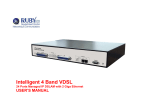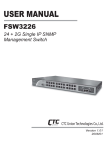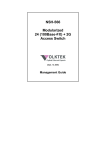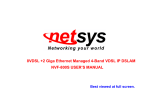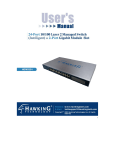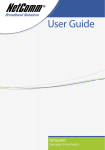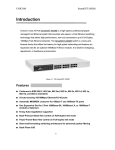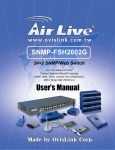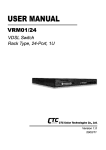Download Edimax ES-3124REM network switch
Transcript
24-Port Ethernet Management Switch (VLAN, Trunking, QoS) ES-5224RM ES-5224REM ES-5224RFM ES-3124REM User’s Manual FCC COMPLIANCE STATEMENT This equipment has been tested and found to comply with the limits of a Class A computing devices, pursuant to Part 15 of the FCC rules. These limits are designed to provide reasonable protection against harmful interference. This equipment generates, uses and can radiate radio frequency energy and, if not installed and used in accordance with the instructions, may cause harmful interference to radio communications. If you suspect this product is causing interference, turn your computer on and off while your radio or TV is showing interference. If the interference disappears then when you turn the computer off and reappears when you turn the computer on, something in the computer is causing interference. You can try to correct the interference by one or more of the following measures: 1. Reorient/relocate the receiving antenna. 2. Increase the separation between the equipment and receiver. 3. Connect the equipment into an outlet on a circuit difference from that to which the receiver is connected. 4. Ensure that all expansion slots (on the back or side of the computer) are covered. Also ensure that all metal retaining brackets are tightly attached to the computer. 2 Content Chapter1 Introduction 1. Introduction ......................................... 6 2. Features & Specifications ................... 8 3. Package Contents............................... 10 4. Hardware Description....................... 11 Chapter 2 Web Management Function 1. Web Management Overview............. 13 2. Port Status .......................................... 15 3. Port Statistics ..................................... 17 4. Administrator .................................... 18 4.1 IP Address ..................................................18 4.2 Switch Settings ..........................................19 4.3 Console Port Information.........................22 4.4 Port Controls .............................................23 4.5 Trunking ....................................................25 4.6 Filter Database ..........................................28 4.7 VLAN configuration .................................31 4.8 Spanning Tree............................................36 4.9 Port Sniffer ................................................38 4.10 SNMP .........................................................39 4.11 Security Manager......................................41 3 4.12 802.1X Configuration ...............................42 4.13 TFTP Update Firmware ...........................45 4.14 Configuration Backup ..............................46 4.15 Reset System ..............................................47 4.16 Reboot ........................................................48 Chapter 3 Console-Menu Line 1. Main Menu......................................... 50 2. Switch Static Configuration.............. 51 2.1 Port Configuration..........................................52 2.2 Trunk Configuration.......................................54 2.3 VLAN Configuration ......................................55 2.4 Misc Configuration .........................................61 2.5 Administration Configuration .......................65 2.6 Port Mirroring Configuration .......................68 2.7 Priority Configuration....................................69 2.8 MAC Address Configuration .........................70 3. Protocol Related Configuration ....... 72 3.1 STP ...................................................................72 3.2 SNMP ...............................................................75 3.3 GVRP ...............................................................80 3.4 IGMP................................................................81 3.5 LACP................................................................83 3.6 802.1X...............................................................86 4. Status and Counters .......................... 89 4 4.1 Port Status........................................................90 4.2 Port Counters ..................................................91 4.3 System Information ........................................92 5. Reboot Switch .................................... 93 5.1 Default ..............................................................93 5.2 Restart ..............................................................93 6. TFTP Update Firmware.................... 94 6.1 TFTP Update Firmware .................................94 6.2 Update Configure File ....................................95 6.3 Upload Configure File ....................................97 5 Chapter 1 Introduction 1. Introduction Congratulations on your purchase of this Fast/Gigabit Ethernet Management Switch. This high performance management switch provides Ethernet ports to segment network traffics, extend Ethernet connection distance, and convert data packets between different transmission speeds. This switch utilizes stored-and-forward switching architecture that filters and forwards data after the complete data packet is received and examined to be free of errors. With one set of status LEDs for each individual port, the switch operation status can be easily monitored. All the Fast Ethernet ports support both Full and Half duplex mode which are able to provide up to 200Mbps(2000Mbps for Gigabit Ports) of bandwidth to the connected devices, with auto-negotiation providing the capability to connect to 100/10Mbps(1000/100/10Mbps for Gigabit ports) network devices. It also supports backpressure and IEEE 802.3x advanced flow control capabilities that can reduce congestion and prevent packet loss. And it offers advance features: SNMP/Web-based Management: Provides a web browser to manage and monitor the switch. Bandwidth Control: Input and output rate control. VLAN: Port-based and Tag-based VLAN allow you to set virtual LANs within your network Trunking: Reduce the bottleneck between switches QoS: Two priority queues per port allow you to define which port has higher priority. 802.1X: This switch supports port-based authentication protocol, IEEE 802.1X. 6 In addition, all the ports support the MDI/MDI-X auto-detect function. That is to say, you can connect any device (including PC, Switch, Hub) to a port of this switch using a regular cable. The RJ-45 port will auto-detect and auto-switch to the correct MDI/MDI-X mode (do not need to use a specific uplink port or cross-over cable). 7 2. Features & Specifications Features Complies with the IEEE802.3 Ethernet, IEEE802.3u Fast Ethernet (IEEE802.3z, IEEE802.3ab for Gigabit switch) Provides Store-and-Forward architecture and full wire speed filtering and forwarding rates 10/100Mbps Ports support full/half duplex modes and auto-negotiation Provides two Fast Ethernet Modules option (Fast/Gigabit Ethernet Management Switch): ♦ 100/10Mbps UTP connector (RJ-45) ♦ 100Mbps Fiber SC/ST connector (multi/single mode) Provides two Gigabit Ethernet Modules option (Gigabit Ethernet Management Switch only): ♦ 1000/100/10Mbps UTP connector (RJ-45) ♦ 1000Mbps Fiber SC connector (multi/single mode) Supports flow control: back pressure for half-duplex mode, IEEE 802.3x for full-duplex mode Supports SNMP, Web-based, Telnet and Console Management MIB: MIBⅡ, Ethernet/Bridge MIB RMON: 4 Groups (1,2,3,9) Supports Port-based VLAN and IEEE802.1Q Tag-based VLAN (up to 256 groups) Supports Trunking: Up to 7 trunking groups Supports Port Mirroring Supports the Spanning Tree Protocol: IEEE 802.1D 19” rack mount size designed 8 Specifications Standards: IEEE802.3, IEEE802.3u, IEEE802.3z, IEEE802.3ab, IEEE802.1Q, IEEE802.1p 10/100Mbps Ports: RJ-45 × 24 Expansion Slot Option (Fast/Gigabit Ethernet Switch): ♦ 10/100Mbps UTP connector (RJ-45) ♦ 100M Fiber SC/ST connector (multi/single mode) Expansion Slot Option (Gigabit Ethernet Switch only): ♦ 1000/100/10Mbps UTP connector (RJ-45) ♦ 1000Mbps Fiber SC connector (multi/single mode) Console Port: DB9 × 1 Forwarding Method: Store-and-Forward MAC Address: 14K Buffer Memory: 512KBytes Flow control: Back pressure for half-duplex and IEEE802.3x for full-duplex Auto-negotiation: All ports Auto-MDI/MDI-X function: All ports System LED indication: Power Port LED indication: LNK/ACT: Link / Activity Speed: 10/100Mbps Dimension: 45(H) × 445(W) × 170(D) mm 1.8(H) × 18(W) × 6.9(D) in Weight: 2.45 Kg / 5.5 lb Operation Temperature: 50~131℉(10~55℃) Operation Humidity: 10~95% (Non-condensing) Power: 100~240V AC, full range internal power supply Emission: FCC Class A, CE, C-Tick 9 3. Package Contents Packing list Check the contents of your package for following parts: One Fast/Gigabit Ethernet Management Switch One User's manual One Power cord One RS-232 Cable If any of the items are missing or damaged, please contact your local dealer. 24-port Fast/Gigabit Ethernet Management Switch power CONSOLE 10 4. Hardware Description This section describes the hardware features of this Fast/Gigabit Ethernet Management Switch. For easier management and control of the switch, familiarize yourself with its display indicators and ports. All LEDs are located on the front panel of the switch. They serve the purpose of monitoring the operation and performance of the switch at a glance. LED indicators 2 4 6 8 10 12 14 16 18 20 22 24 LNK/ACT 100M LNK/ACT power 100M 1 3 5 7 9 11 LNK: ON LNK/ACT ACT: Blink 100M ON:100M OFF:10M 11 13 15 17 19 21 23 Operating Environment This management switch must be installed and operated within the limits of the specified operating temperature and humidity (see previous section on Specifications). Do not place objects on top of the unit or obstruct any vents at the sides of the unit. Do not position the unit near any heating source such as heaters, radiators, or direct exposure to sun. Do not expose the unit to water and or moisture. If necessary, use a dehumidifier to reduce humidity. Connecting to network devices 1. 2. 3. All ports of this switch support the Auto-MDI/MDI-X function. That is to say, you can connect any device (including PC, Switch, Hub) to a port of this switch using a regular cable. The RJ-45 port will auto-detect and auto-switch to the correct MDI/MDI-X mode. (do not need to connect to a specific uplink port or cross-over cable) Connect one end of the network cable to the RJ-45 port on the front panel, and connect the other end of the network cable to the RJ-45 port on the network device. Follow the same procedure to connect all the RJ-45 ports of the switch. Maximum length, using UTP cable, between the switch and connected device is 100 meters (300ft). Once the network cable is connected to both ends and the attached network device is powered on, the LNK/ACT LED should be lit. Make sure the wiring is correct. You need to use Category 3/4/5 cable for 10Mbps operation or Category 5 cable for 100Mbps connections. Connecting the power Plug the power cable into the internal three-pronged power plug. Connect it to an electrical outlet then turn on the switch. 12 Chapter 2 Web Management Function 1. Web Management Overview This switch provides a web browser to manage and monitor. The default values are as follows: IP Address: 192.168.223.100 Subnet Mask: 255.255.248.0 Default Gateway: 192.168.223.254 User Name: admin Password: 123 You can browse http://192.168.223.100, type user name and password as below. 13 After type in the correct username and password, you can see the homepage as follows: 14 2. Port Status Click the port status icon on the menu column you will see the port status page. In this page, you can see the status of each port that depended on user’s settings and the negotiation results. 1. State: Displays the status of each port (“on” means enable and “off” means disable). “Unlink” will be treated as “off ”. 2. Link Status: “Down” and “Up” means “No Link” and “Link” respectively. 3. Negotiation: Displays the auto negotiation modes: auto, force and nway-force. 4. Speed status: Displays the speed of each port: Port 1- 24 are 10/100Mbps Port 25-26 are 10/100/1000Mbps(Gigabit Ethernet Switch) 10/100Mbps(Fast Ethernet Switch) 5. Duplex status: Displays the port is full-duplex mode or half-duplex mode. 6. Flow Control: Full: Displays the flow control status is enable or disable in full duplex mode. Half: Displays the backpressure is enable or disable in half duplex mode. 15 7. Rate Control: Displays the rate control settings. Ingr: Displays the port’s effective ingress rate of user settings. Egr: Displays the port’s effective egress rate of user settings. 8. Port Security: Shows the port security is enabled or disabled. 9. Config: Displays the state of user’s settings. 10. Atual: Displays the negotiation results. You can see a single port counter by clicking on each port as following. 16 3. Port Statistics The following information provides a view of the current status of the switch. Press “Reset” button to clean all count. 17 4. Administrator This management switch provides advance features, which offers you more flexibility in setting up your network. The following sections explain how to set up the IP address, Switch settings, Console port information, Port controls, Trunk configuration, Filter database, VLAN configuration, Spanning tree, Port Sniffer, SNMP management, Security Manager, TFTP Update Firmware, Configuration Backup, Reset system and Reboot etc. 4-1 IP Address You can configure the IP Settings and fill in the new values, than click “Apply” button. You must restart the switch then use new IP address to browse this web management. 18 4.2 Switch Settings 4.2.1 Basic Description: Displays the name of this management switch. MAC Address: The unique hardware address is assigned by manufacturer (default). Firmware Version: Displays the switch’s firmware version. ASIC Version: Displays the switch’s Hardware version. PCBA version: Displays the switch’s PCBA version. Serial number: The serial number is assigned by manufacturer. 4.2.2 Module Info Displays the module card informations. Note: The module type will be 100/10Mbps for Fast Ethernet Management Switch (1000/100/10Mbps for Gigabit Switch). 19 4.2.3 Advanced Miscellaneous Settings: MAC Address Age-out Time: Type the number of seconds that an inactive MAC address remains in the switch's address table. The valid range is 300~765 seconds. Default is 300 seconds. Max bridge transit delay bound control: Limit the packets queuing time in switch. If enable, the packets queued exceed the time will be droped. This valid value are 1sec, 2 sec, 4 sec and off. Default is 1 second. Broadcast Storm Filter Mode: To configure broadcast storm control, enable it and set the upper threshold for individual ports. The threshold is the percentage of the port's total bandwidth used by broadcast traffic. When broadcast traffic for a port rises above the threshold you set, broadcast storm control becomes active. The valid threshold value are 5%, 10%, 15%, 20%, 25% and off. Priority Queue Service settings: First Come First Service: The sequence of packets sent is depend on arrive order. All High before Low: The high priority packets sent before low priority packets. WRR: Weighted Round Robin. Select the preference given to packets in the switch's high-priority queue. These options represent the number of high priority packets sent before one low priority packet is sent. For example, 2 High : 1 Low means 20 that the switch sends 2 high priority packets before sending 1 low priority packet. Qos Policy: High Priority Levels, 0~7 priority levels, can map to high or low queue. Collisions Retry Forever: Enable it or just disable this function. 802.1X Protocol: IEEE 802.1X is port-based authentication protocol. You can enable it to control users’ access to the internet. 21 4.3 Console Port Information Console is a standard UART interface to communicate with Serial Port. You can use windows HyperTerminal program to link the switch. Connect To->Configure Bits per second: 9600 Data bits: 8 Parity: none Stop Bits: 1 Flow control: none 22 4.4 Port Controls You can change the status of each port in this page. 1.State: You can enable or disable this port. 2.Auto Negotiation: You can set auto negotiation mode as Auto, Nway (specify the speed/duplex on this port and enable auto-negotiation) or Force of each port. 3.Speed: You can set 100 or 10Mbps speed on Port1~Port24. And set 1000/100/10Mbps on Port25~Port26 (Gigabit Ethernet switch) or 100/10Mbps on Port25~Port26 (Fast Ethernet switch). 4.Duplex: You can set each port as full-duplex or half-duplex mode. 5.Flow control: Full: You can set flow control function is enable or disable in full duplex mode. Half: You can set backpressure is enable or disable in half duplex mode. 6.Rate Control: This switch, port1 ~ port 24, supports by-port ingress and egress rate control. For example, assume port 1 is 10Mbps, users can set it’s effective egress rate is 1Mbps, ingress rate is 500Kbps. This switch will perform flow control or backpressure to confine the ingress rate to meet the specified rate. Ingress: Type the port effective ingress rate. The valid range is 0 ~ 1000. The unit is 100K 0: disable rate control 1 ~ 1000: valid rate value Egress: Type the port effective egress rate. The valid range is 0~1000. The unit is 100K. 23 0: disable rate control 1 ~ 1000: valid rate value. 7.Port Security: A port in security mode will be “locked” without permission of address learning. Only the incoming packets with SMAC already existing in the address table can be forwarded normally. You can disable the port from learning any new MAC addresses then use the static MAC addresses screen to define a list of MAC addresses that can use the secure port. Enter the settings, then click Apply button to changes on this page. 24 4.5 Trunking The Link Aggregation Control Protocol (LACP) provides a standardized means for exchanging information between Partner Systems on a link to allow their Link Aggregation Control instances to reach agreement on the identity of the Link Aggregation Group to which the link belongs, move the link to that Link Aggregation Group, and enable its transmission and reception functions in an orderly manner. In conclusion, Link aggregation lets you group up to eight consecutive ports into a single dedicated connection. This feature can expand bandwidth to a device on the network. LACP operation requires full-duplex mode, more detail information refers to IEEE 802.3ad. 4.5.1 Aggregator setting System Priority: A value used to identify the active LACP. The switch with the lowest value has the highest priority and is selected as the active LACP. 1.Group ID: There are seven trunk groups to provided configure. Choose the "group id" and click "Get". 2.LACP: If enable, the group is LACP static trunking group. If 25 disable, the group is local static trunking group. All ports support LACP dynamic trunking group. If connecting to the device that also supports LACP, the LACP dynamic trunking group will be created automatically. 3. Work ports: Allow max four ports can be aggregated at the same time. If LACP static trunking group, the exceed ports is standby and able to aggregate if work ports fail. If local static trunking group, the number must be as same as the group member ports. 4 Select the ports to join the trunking group. Allow max four ports can be aggregated at the same time. 5. If LACP enable, you can configure LACP Active/Passive status in each ports on State Activity page. 6. Click Apply. 4.5.2 Aggregator Information When you are setting LACP aggregator, you can see relation information here. 1. This page is no group active. LACP don’t working. 2. This page is Static Trunking group. 26 4.5.3 State Activity Active (selected): The port automatically sends LACP protocol packets. Passive (not selected): The port does not automatically sends LACP protocol packets, and responds only if it receives LACP protocol packets from the opposite device. 1. A link having either two active LACP ports or one active port can perform dynamic LACP trunking. A link has two passive LACP ports will not perform dynamic LACP trunking because both ports are waiting for LACP protocol packets from the opposite device. 2. If you are active LACP actor, when you select trunking port, the active status will be created automatically. 27 4.6 Filter Database 4.6.1 IGMP Snooping This switch supports IP multicast, you can enable IGMP protocol on web management’s switch settings advanced page, then display the IGMP snooping information in this page, you can view difference multicast group ,VID and member port here, IP multicast addresses range from 224.0.0.0 through 239.255.255.255. The Internet Group Management Protocol (IGMP) is an internal protocol of the Internet Protocol (IP) suite. IP manages multicast traffic by using switches, routers, and hosts that support IGMP. Enabling IGMP allows the ports to detect IGMP queries and report packets and manage IP multicast traffic through the switch. 4.6.2 Static MAC Address When you add a static MAC address, it remains in the switch's address table, regardless of whether the device is physically connected to the switch or not. This saves the switch from having to re-learn a device's MAC address when the disconnected or powered-off device is active on the network again. 28 Steps to add Static MAC Address: 1. From the main menu, click administrator->Filter Database ->Static MAC Address. 2. In the MAC address box, enter the MAC address to and from which the port should permanently forward traffic, regardless of the device’s network activity. 4. In the Port Number box, enter a port number. 5. If tag-based (IEEE 802.1Q) VLANs are set up on the switch, static addresses are associated with individual VLANs. Type the VID (tag-based VLANs) to associate with the MAC address. 6. Click add. 29 4.6.3 MAC Filtering MAC address filtering allows the switch to drop unwanted traffic. Traffic is filtered based on the destination addresses. Steps to specify a MAC address to filter: 1.In the MAC Address box, enter the MAC address that wants to filter. 2. If tag-based (802.1Q) VLAN are set up on the switch, in the VLAN ID box, type the VID to associate with the MAC address. 3. Click the Add. 4. Choose the MAC address that you want to delete and then click the Delete can delete it. 30 4.7 VLAN Configuration A Virtual LAN (VLAN) is a logical network group that limits the broadcast domain. It allows you to isolate network traffic so only members of the VLAN receive traffic from the same VLAN members. Basically, creating a VLAN from a switch is logically equivalent of reconnecting a group of network devices to another Layer 2 switch. However, all the network devices are still plug into the same switch physically. This switch supports both port-based and 802.1Q (tagged-based) VLAN in web management page. In the default configuration, VLAN support is disabled. NOTE: You have to reboot the switch for valid value every time you change the VLAN mode. 31 4.7.1 Port-based VLAN Steps to create a new VLAN group based on port-based VLAN: 1.Click Add to create a new VLAN group. 2.Enter the VLAN name, group ID and select the members for the new VLAN. 3.Click Apply. 4.If there are many groups that over the limit of one page, you can click the “NextPage” to view other VLAN groups. NOTE: If the trunk group exists, you can see it (ex: TRK1, TRK2...) in select menu of ports, and you can configure it as the member of the VLAN or not. 32 4.7.2 802.1Q VLAN In this page, you can create Tag-based VLAN, and enable or disable GVRP protocol. There are 256 VLAN groups to configure. Enable 802.1Q VLAN, the all ports on the switch belong to default VLAN, VID is 1. The default VLAN can’t be deleted. GVRP (GARP [Generic Attribute Registration Protocol] VLAN Registration Protocol) GVRP allows automatic VLAN configuration between the switch and nodes. If the switch is connected to a device with GVRP enabled, you can send a GVRP request using the VID of a VLAN defined on the switch, then it will automatically add that device to the existing VLAN. 33 Basic Create a VLAN and add tagged member ports to it. 1. From the main menu, click administrator-> VLAN configuration, click Add then you will see the page as follow. 2. 3. 4. 5. Type a name for the new VLAN. Type a VID (between 2-4094). The default is 1. Choose the protocol type. From the Available ports box, select ports to add to the VLAN and click “Add >>”. If the trunk group exists, you can see it here (ex: TRK1,TRK2…), and you can configure it as the member of the VLAN or not. 6. Click Next. Then you can view the page as follow. 7. Use this page to set the outgoing frames as VLAN-Tagged frames or no. Then click Apply. Tag: outgoing frames with VLAN-Tagged. Untag: outgoing frames without VLAN-Tagged. 34 Port VID Configure port VID settings From the main Tag-based (IEEE 802.1Q) VLAN page, click Port VID Settings. Port VID (PVID) Set the port VLAN ID that will be assigned to untagged traffic on a given port. This feature is useful for accommodating devices that you want to participate in the VLAN but that don’t support tagging. Each port of this switch allows user to set one PVID, the range is 1~255, default PVID is 1. The PVID must be the same as the VLAN ID the port belongs to, or the untagged traffic will be dropped. Ingress Filtering Ingress filtering lets frames belonging to a specific VLAN to be forwarded if the port belongs to that VLAN. This switch have two ingress filtering rule as follows: Ingress Filtering Rule 1: Forward only packets with VID matching this port's configured VID. Ingress Filtering Rule 2: Drop Untagged Frame. 35 4.8 Spanning Tree The Spanning-Tree Protocol (STP) is a standardized method (IEEE 802.1D ) for avoiding loops in switched networks. When STP enabled, ensure that only one path at a time is active between any two nodes on the network. You can enable Spanning-Tree Protocol on web management’s switch setting advanced item by selecting enable Spanning-Tree protocol. We are recommended that you enable STP on all switches ensures a single active path on the network. 1.You can view spanning tree information about the Root Bridge, such as following screen. 2.You can view spanning tree status about the switch, such as following screen. 3. You can set new value for STP parameter, then click Apply button to modify. 36 Parameter Priority Max Age Hello Time Forward Delay Time Description You can change priority value, A value used to identify the root bridge. The bridge with the lowest value has the highest priority and is selected as the root. Enter a number 1 through 65535. You can change Max Age value, The number of seconds a bridge waits without receiving Spanning-Tree Protocol configuration messages before attempting a reconfiguration. Enter a number 6 through 40. You can change Hello time value, the number of seconds between the transmission of Spanning-Tree Protocol configuration messages. Enter a number 1 through 10. You can change forward delay time, The number of seconds a port waits before changing from its Spanning-Tree Protocol learning and listening states to the forwarding state. Enter a number 4 through 30. 4. The following parameter can be configured on each port, click Apply button to modify. Parameter Port Priority Path Cost Description You can make it more or less likely to become the root port, the rage is 0-255,default setting is 128 the lowest number has the highest priority. Specifies the path cost of the port that switch uses to determine which port are the forwarding ports the lowest number is forwarding ports, the rage is 1-65535 and default value base on IEEE802.1D 10Mb/s = 50-600 100Mb/s = 10-60 1000Mb/s = 3-10 37 4.9 Port Sniffer The Port Sniffer is a method for monitor traffic in switched networks. Traffic through ports can be monitored by one specific port. That is, traffic goes in or out monitored ports will be duplicated into sniffer port. 1.Roving Analysis State: Press Space key to set sniffer mode as Disable, Rx, Tx or Both. 2.Analysis Port: It means sniffer port which can be used to see all monitored port traffic. You can connect analysis port to Lan analysier or netxray. 3.Monitored Port: The ports you want to monitor. All monitor ports’ traffic will be copied to analysis port. You can select max 25 monitor ports in the switch. You can choose which port want to be monitored in only one sniffer mode. 38 4.10 SNMP Any Network Management running the simple Network Management Protocol (SNMP) can management the switch, provided the Management Information Base (MIB) is installed correctly on the management station. The SNMP is a Protocol that governs the transfer of information between management and agent. This switch supports SNMP V1. 1. Use this page to define management stations as trap managers and to enter SNMP community strings. You can also define a name, location, and contact person for the switch. Fill in the system options data then click Apply to update the changes on this page. Name: Enter a name to be used for the switch. Location: Enter the location of the switch. Contact: Enter the name of a person or organization. 39 2. Community strings serve as passwords and can be entered as one of the following: RO: Read only. Enables requests accompanied by this string to display MIB-object information. RW: Read write. Enables requests accompanied by this string to display MIB-object information and to set MIB objects. 3. Trap Manager A trap manager is a management station that receives traps, the system alerts generated by the switch. If no trap manager is defined, no traps are issued. Create a trap manager by entering the IP address of the station and a community string. 40 4.11 Security Manager Use this page you can change web management user name and password. 1.User name: Type the new user name. 2. Password: Type the new password. 3. Reconfirm password: Retype the new password. 4. Click Apply. 41 4.12 802.1X Configuration If you enable the IEEE 802.1X function, you can configure the parameters of this function. System Configuration 1. Radius Server IP: Set the Radius Server IP address 2. Server Port: Set the UDP destination port for authentication requests to the specified Radius Server. 3. Accounting Port: Set the UDP destination port for accounting requests to the specified Radius Server. 4. Shared Key: Set an encryption key for use during authentication sessions with the specified radius server. This key must match the encryption key used on the Radius Server. 5. NAS, Identifier: Set the identifier for the radius client. 42 Perport Configuration: There are four types for each port: Fu, Force unauthorized: The specified port is required to be held in the Unauthorized state. Fa, Force authorized: The specified port is required to be held in the Authorized state. Au, Auto: The specified port is set to the Authorized or Unauthorized state in accordance with the outcome of an authentication exchange between the Supplicant and the authentication server. No, None: The specified port is required to be held in the Authorized state. 43 1. 2. 3. 4. 5. 6. MISC Configuration Quiet period: Set the period during which the port doesn’t try to acquire a supplicant. Tx period: Set the period the port waits to retransmit next EAPOL PDU during an authentication session. Supplicant timeout: Set the period of time the switch waits for a supplicant response to an EAP request. Server timeout: Set the period of time the switch waits for a server response to an authentication request. Max requests: Set the number of authentication attemps that must time-out before authentication fails and the authentication session ends. Reauth period: Set the period of time after which clients connected must be re-authenticated. 44 4.13 TFTP Update Firmware The following menu options provide some system control functions to allow a user to update firmware and remote boot switch system: 1. Install TFTP Turbo98 and execution. 2. Copy firmware update version image.bin to TFTP Turbo98 directory. 3. In web management select administrator—TFTP update firmware. 4. Download new image.bin file then in web management press <update firmware>. 5. After update finished, press <reboot> to restart switch. 45 4.14 Configuration Backup 4.14.1 TFTP Restore Configuration Use this page to set tftp server address. You can restore EEPROM value from here, but you must put back image in tftp server, switch will download back flash image. 4.14.2 TFTP Backup Configuration Use this page to set tftp server IP address. You can save current EEPROM value from here, then go to the TFTP restore configuration page to restore the eeprom value. 46 4.15 Reset System Reset the Switch to default configuration, default value as below 47 4.16 Reboot Reboot the system in software reset. 48 Chapter 3 Console-Menu Line This switch also provides a serial interface to manage and monitor, you can follow the Console Port Information provided by web to use windows HyperTerminal program to link the switch. You can type user name and password to login. The default user name is “admin” with password “123 ”. 49 1. Main Menu There are six items for selected as follows: Switch Static Configuration: Configure the switch. Protocol Related Configuration: Configure the protocol function. Status and Counters: Show the status of the switch. Reboot Switch: Restart the system or reset switch to default configuration. TFTP Update Firmware: Use tftp to download image. Logout: Exit the menu line program. <Control Key> The control keys as follow provided in all menus: Tab: Move the vernier to next item. Backspace: Move the vernier to previous item. Enter: Select item. Space: Toggle selected item to next configure. 50 2. Switch Static Configuration You can press the key of Tab or Backspace to choose item, and press Enter key to select item. The action menu line as follow provided in later configure page. Actions-> <Quit>: Exit the page of port configuration and return to previous menu. <Edit>: Configure all items. Finished configure press Ctrl+A to go back action menu line. <Save>: Save all configure value. <Previous Page>: Return to previous page to configure. <Next page>: Go to next page to configure. 51 2.1 Port Configuration This page can change the status of each port. Press <Space> key to change configuration of each item. 1. InRate(100K/unit): You can set input rate control, per unit is 100K. The valid range is 0~1000. 0: disable rate control. 1~1000: valid rate value. 2. OutRate(100K/unit): You can set output rate control, per unit is 100K. The valid range is 0~1000. 0: disable rate control. 1~1000: valid rate value. 3.Enable: You can disable or enable this port control. “Yes” means the port is enabled, “No” means the port is disabled. 4.Auto: You can set auto-negotiation mode as Auto, Nway_Force or Force of each port. 5.Spd/Dpx: You can set 100/10Mbps speed on port 1~port24; 1000/100/10Mbps speed on port25~port26 (Gigabit Switch), 100/10Mbps speed on port25~port26 (Fast Ethernet Switch) and set full-duplex or half-duplex mode. 6. Flow Control: Full: Displays the flow control status is enable/disable in full 52 duplex mode. Half: Displays the backpressure is enable/disable in half duplex mode. NOTE: 1. Pressing <Save> only can save one page configuration. 2. If the static trunk group exists, you can see it (ex: TRK1, TRK2…) after port 26, and you can configure all of the items as above. 53 2.2 Trunk Configuration This page can create max to seven trunk groups. You can arbitrarily select up to four ports from port 1~port 24/port25 ~ port26 to build a trunking group. 1. Select <Edit> on actions menu. 2. Press <Space> key to configure the member port of the trunk group. Besides, you have to set “Static” or “LACP” for the corresponding trunk group of TRK1~TRK7 item. “Static” – the normal trunk. “LACP” – this trunk group have link aggregation control protocol. 3. Press Ctrl+A to go back action menu line. 4. Select <Save> to save all configure value. 5. If the item of TRK1~TRK7 is set “Disable”, it means the trunk group is deleted. 6. All ports in the same static trunk group will be treated as single port. So when you setting VLAN members and Port configuration they will be toggled on or off simultaneously. NOTE: If VLAN group exists, all of the members of static trunk group must be in same VLAN group. 54 2.3 VLAN Configuration 2.3.1 VLAN Configure This page can set VLAN mode as port-based VLAN, 802.1Q VLAN or just disable the VLAN function. NOTE: You have to restart the switch for valid value every time you change the VLAN mode. 55 If set 802.1Q VLAN, you can set PVID, ingress filtering 1 and ingress filtering 2 in this page too. 1.PVID (Port VID : 1~255): Type the PVID. 2.NonMember Pkt: It matches that Ingress Filtering Rule 1 on web management. It will forward only packets with VID matching this port’s configured VID. Press Space key to choose forward or drop the frame that VID not matching this port’s configured VID. 3.UnTagged Pkt: It matches that Ingress Filtering Rule 2 on web management. It will drop untagged frames. Press Space key to choose drop or forward the untagged frames. 56 2.3.2 Create a VLAN Group Create Port-based VLAN and add member/nonmember ports to it 1.Select <Edit>. 2.VLAN Name: Type a name for the new VLAN. 3.Grp ID: Type the VLAN group ID. The group ID range is 1~26. 4.Member: Press Space key to choose VLAN member. There are two types to select: a. Member: the port is a member port. b. NO: the port is NOT a member port. 5.Press Ctrl+A go back action menu line. 6.Select <Save> to save all configure value. NOTE: If the trunk group exists, you can see it (ex: TRK1, TRK2…) after port26, and you can configure it is the member of the VLAN or not. 57 Create 802.1Q VLAN and add tagged /untagged member ports to it 1.Select <Edit>. 2.VLAN Name: Type a name for the new VLAN. 3.VLAN ID: Type a VID (between 2~4094). The default is 1. There are 256 VLAN groups to configure. 3.Protocol VLAN: Press Space key to choose protocol types. 4.Member: Press Space key to choose VLAN members. There are three types to select: UnTagged: this port is the member port of this VLAN group and outgoing frames are NO VLAN-Tagged frames. Tagged: this port is the member port of this VLAN group and outgoing frames are VLAN-Tagged frames. NO: The port is NOT member of this VLAN group. 5.Press Ctrl+A go back action menu line. 6.Select <Save> to save all configure value. NOTE: If the trunk group exists, you can see it (ex: TRK1, TRK2…) after port26, and you can configure it as the member of the VLAN or not. 58 2.3.3 Edit / Delete a VLAN Group In this page, you can edit or delete a VLAN group. 1.Press <Edit> or <Delete> item. 2.Choose the VLAN group that you want to edit or delete and then press enter. 3.You can modify the protocol VLAN item and the member port as tagged or un-tagged and remove some member ports from this VLAN group. 4.After edit VLAN, press <Save> key to save all configures value. NOTE: 1. Press <Enter> once will complete deletion on delete mode. 2. The VLAN Name and VLAN ID cannot be modified. 3. The default VLAN can’t be deleted. 59 2.3.4 Groups Sorted Mode In this page, you can select VLAN groups sorted mode as (1) sorted by name (2) sorted by VID. In the Edit/Delete a VLAN group page will display the result. In the Edit/Delete a VLAN Group page, the result of sorted by name. In the Edit/Delete a VLAN Group page, the result of sorted by VID. 60 2.4 Misc Configuration 2.4.1 MAC Age Interval Type the number of seconds that an inactive MAC address remains in the switch’s address table. The valid range is 300~765 seconds. Default is 300 seconds. 61 2.4.2 Broadcast Storm Filtering In this page you can configure broadcast storm settings. 1.Press <Edit> to configure the broadcast storm filter mode. 2.Press Space key to choose the threshold value. The valid threshold value are 5%,10%,15%,20%,25% and NO. 62 2.4.3 Max bridge transmit delay bound 1.Max bridge transmit delay bound: Limit the packets queuing time in switch. If enable, the packets queued exceed will be drop. Press Space key to set the time. This valid value are 1sec, 2sec, 4sec and off. Default is off. 2.Low Queue Delay Bound: Limit the low priority packets queuing time in switch. If enable, the low priority packet stays in switch exceed Low Queue Max Delay Time, it will be sent. Press Space key to enable or disable this function. 3.Low Queue Max Delay Time: To set the time that low priority packets queuing in switch. Default Max Delay Time is 255ms. The valid range is 1~255 ms. NOTE: Make sure of “Max bridge transit delay bound control” is enabled before enable Low Queue Delay Bound, because Low Queue Delay Bound must be work under “Max bridge transit delay bound control” is enabled situation. 63 2.4.4 Port Security A port in security mode will be “locked” without permission of address learning. Only the incoming packets with SMAC already existing in the address table can be forwarded normally. You can disable the port from learning any new MAC addresses, then use the static MAC addresses screen to define a list of MAC addresses that can use the secure port. 1.Select <Edit>. 2.Press Space key to choose enable / disable item. 3.Press Ctrl+A to go back action menu line. 4.Select <Save> to save all configure value. 4. You can press <Next Page> to configure port9 ~ port26 and press <Previous Page> to return to last page. 64 2.5 Administration Configuration 2.5.1 Change Username You can change web management user name in this page. Type the new user name, then press <Save> item. 65 2.5.2 Change Password In this page you can change web management login password. 2.5.3 Device Information This page provide user to configure the device information. 66 2.5.4 IP Configuration You can configure the IP setting and fill in the new value. 67 2.6 Port Mirroring Configuration The port mirroring is a method for monitor traffic in switched networks. Traffic through ports can be monitored by one specific port. That is, traffic goes in or out monitored ports will be duplicated into monitoring port. Press Space key to change configure of each item. 1.Select <Edit>. 2.Sniffer Mode: Press Space key to set sniffer mode: Disable\Rx\Tx\Both. 3.Monitoring Port: It means sniffer port can be used to see all monitor port traffic. Press Space key to choose it. 4.Monitored Port: The ports you want to monitor. All monitor port traffic will be copied to sinffer port. You can select max 25 monitor ports in the switch. You can choose which port want to be monitored in only one sniffer mode. Press Space key to choose member port, “V” – is the member, “—“ – not the member. 5.Press Ctrl+A go back action menu line 6.Select <Save> to save all configure value. 7.On the action menu line you can press <Next Page> to configure port9 ~ port26, press <Previous Page> return to last page. NOTE: Only have one sniffer mode in this switch at the same time. 68 2.7 Priority Configuration There are 0~7 priority levels can map to high or low queue. 1.Select <Edit>. 2.Press Space key to select the priority level mapping to high or low queue. 3.High/Low Queue Service Ration H:L : You can select the ratio of high priority packets and low priority packets. 4.Press Ctrl+A go back action menu line. 5.Selcet <Save> to save all configure value. 69 2.8 MAC Address Configuration 2.8.1 Static MAC Address When you add a static MAC address, it remains in the switch's address table, regardless of whether the device is physically connected to the switch. This saves the switch from having to re-learn a device's MAC address when the disconnected or powered-off device is active on the network again. In this page you can add/modify/delete a static MAC address. 70 2.8.2 Filtering MAC Address MAC address filtering allows the switch to drop unwanted traffic. Traffic is filtered based on the destination addresses. In this page you can add/modify/delete the filtering MAC address. 71 3. Protocol Related Configuration 3.1 STP 72 3.1.1 STP Enable You can enable or disable Spanning Tree function in this page. Press Space key to select enable or disable. 3.1.2 System Configuration 1.You can view spanning tree information about the Root Bridge on the left. 2.On the right, you can set new values for STP parameters. 73 3.1.3 Perport Configuration 1.PortState: Display spanning tree status about the switch for per port as forwarding or blocking. 2.Select <Edit>. 3.PathCost: Specifies the path cost of the port that switch uses to determine which port are the forwarding ports. 4.Priority: This means port priority. You can make it more or less likely to become the root port. 5.Press Ctrl+A go back action menu line. 6.Select <Save> to save all configure value. 7.On the action menu line you can press <Next Page> to configure port9 ~ port26, press <Previous Page> to return to last page. 74 3.2 SNMP Use this page to define management stations as trap managers and to enter SNMP community strings. You can also define a name, location, and contact person for the switch. 75 3.2.1 System Options 1.Press <Edit>. 2.System Name: Type a name to be used for the switch. 3.System Contact: Type the name of contact person or organization. 4.System Location: Type the location of the switch. 5.Press Ctrl+A go back action menu line. 6. Press <Save> to save configure value. 76 3.2.2 Community Strings Use this page to add/edit/delete SNMP community strings. 1.Community Name: The name of current strings. 2.Write Access: Enable the rights is read only or read write. Restricted: Read only, enables requests accompanied by this string to display MIB-object information. Unrestricted: Read write, enables requests accompanied by this string to display MIB-object information and to set MIB objects. 77 3.2.3 Trap Managers A trap manager is a management station that receives traps, the system alerts generated by the switch. If no trap manager is defined, no traps are issued. Create a trap manager by entering the IP address of the station and a community string. Add the trap manager 1.Press <Add> -> <Edit> to add the trap manager. 2.IP: Type the IP address. 3.Community Name: Type the community name. 4.Press Ctrl+A go to actions line, then press <Save> key to save all configure. 78 Edit trap manager 1.Press <Edit> key to choose the item that you want to modify. 2.Press <Edit> key. 3.IP: Type the new IP address. 4.Community Name: Type the community name. 5.Press Ctrl+A go to actions line, press <Save> key to save all configure. Delete trap manager 1.Press <Delete> key. 2.Choose the trap manager that you want to delete and then press enter. 3. Press <Enter> once will complete deletion on delete mode. 79 3.3 GVRP In this page you can enable/disable the GVRP (GARP VLAN Registration Protocol) support. 1.Select <Edit>. 2.Press Space key to choose Enabled / Disabled. 3.Press Ctrl+A go back action menu line. 4.Select <Save> to save configure value. 80 3.4 IGMP In this page you can enable / disable the IGMP support. 1.Select <Edit>. 2.Press Space key to choose Enabled / Disabled. 3.Press Ctrl+A go back action menu line. 4.Select <Save> to save configure value. 81 3.5 LACP In this page you can configure and view all the LACP status. 82 3.5.1 Working Port Setting This page can set the actually work ports in trunk group. 1.Select <Edit>. 2.Group: Display the trunk group ID. 3.LACP: Display the trunk group’s LACP status. 4.LACP Work Port Num: The max number of ports can be aggregated at the same time. If LACP static trunking group, the exceed ports is standby and able to aggregate if work ports fail. NOTE: Before set this page, you have to set trunk group on the page of Trunk Configuration first. 83 3.5.2 State Activity 1.Select <Edit>. 2.Press Space key to choose the item. Active: The port automatically sends LACP protocol packets. Passive: The port does not automatically send LACP protocol packets, and responds only if it receives LACP protocol packets from the opposite device. 3.Press Ctrl+A go back action menu line. 4.Select <Save> to save configure value. If user set LACP mode in the trunk group, all of the member ports of this trunk group will set "Active" automatic. 84 3.5.3 LACP Status When you set trunking groups you can see relation information here. <Quit>: Exit this page and return to previous menu. <Previous Page>: Return to previous page to view. <Next page>: Go to next page to view. 85 3.6 802.1X Configuration 3.6.1 Enable 802.1X function Press Space key to enable or disable the 802.1x function. 86 3.6.2 System Configuration If you enable the IEEE 802.1X function, you can configure the parameters of this function. 1. Radius Server IP: Set the Radius Server IP address 2. Shared Key: Set an encryption key for use during authentication sessions with the specified radius server. This key must match the encryption key used on the Radius Server. 3. NAS, Identifier: Set the identifier for the radius client. 4. Server Port: Set the UDP destination port for authentication requests to the specified Radius Server. 5. Accounting Port: Set the UDP destination port for accounting requests to the specified Radius Server. There are four types for each port: Fu, Force unauthorized: The specified port is required to be held in the Unauthorized state. Fa, Force authorized: The specified port is required to be held in the Authorized state. Au, Auto: The specified port is set to the Authorized or Unauthorized state in accordance with the outcome of an authentication exchange between the Supplicant and the authentication server. No, None: The specified port is required to be held in the Authorized state. 87 3.6.3 Misc Configuration 1. Quiet period: Set the period during which the port doesn’t try to acquire a supplicant. 2. Tx period: Set the period the port waits to retransmit next EAPOL PDU during an authentication session. 3. Supplicant timeout: Set the period of time the switch waits for a supplicant response to an EAP request. 4. Server timeout: Set the period of time the switch waits for a server response to an authentication request. 5. Max requests: Set the number of authentication attemps that must time-out before authentication fails and the authentication session ends. 6. Reauth period: Set the period of time after which clients connected must be re-authenticated 88 4. Status and Counters You can press the key of Tab or Backspace to choose each item, and press Enter key to select the item. 89 4.1 Port Status This page displays the status of each port. Link Status: “Down” and “Up” means “No Link” and “Link” respectively. InRate: Displays the input rate control (100K/unit) setting values. OutRate: Displays the output rate control (100K/unit) setting values. Enabled: Displays the port is enabled or disable depended on user settings. Enable will be displayed as “Yes”, disable will be displayed as “No”. If the port is unlink it will be treated as “No”. Auto: Displays the port is link on which Nway mode: Auto , Nway_Force , Force. Spd/Dpx: Displays the port speed and duplex. Flow Control: In auto / Nway force mode, displays the flow control status is enable or disable after negotiation. In force mode, displays the flow control status is enable or disable depending on user settings. 90 4.2 Port Counters The following information provides a view of the current status of the unit. <Quit>: Exit the page of port status, and return to previous menu. <Reset All>: Set all count to 0. <Previous Page>: Display previous page. <Next page>: Display next page. 91 4.3 System Information MAC Address: The unique hardware address assigned by manufacturer. Firmware Version: Display the switch’s firmware version. Hardware Version: Display the switch’s Hardware version. Default config value version: Display write to default eeprom value tale version. Module1 information: Display the information saved in eeprom of module1. Module2 information: Display the information saved in eeprom of module2. 92 5. Reboot Switch 5.1 Default Reset switch to default configuration. 5.2 Restart Reboot the switch in software reset. 93 6. TFTP Update Firmware This page provides you to update firmware or restore EEPROM value or upload current EEPROM values. 6.1 TFTP Update Firmware This page provides you use TFTP to update firmware. 1. Start the TFTP server, and copy firmware update version image file to TFTP server. 2. Press <Edit> on this page. 3. TFTP Server: Type the IP of TFTP server. 4. Remote File Name: Type the image file name. 5. Press Ctrl+A to go back action line. 6. Press <Save> key, it will start to download the image file. 7. When save successfully, the image file download finished too. 8. Restart the switch. 94 6.2 Update Configure File In this page you can restore EEPROM values, save image file before, from TFTP server. 1. Start the TFTP server. 2. Press <Edit> on this page. 3. TFTP Server: Type the IP of TFTP server. 4. Remote File Name: Type the image file name. 5. Press Ctrl+A go to action line. 6. Press <Save> key, it will start to download the image file. 7. When save successfully, the image file download finished too. 8. Restart switch. 95 96 6.3 Upload Configure File In this page you can save current EEPROM values to image file. Then go to the update configure page to restore the EEPROM values. 1. Start the TFTP server. 2. Press <Edit> on this page. 3. TFTP Server: Type the IP of TFTP server. 4. Remote File Name: Type the image file name. 5. Press Ctrl+A go to action line. 6. Press <Save> key, it will start to upload the image file. 7. When save successfully, the image file upload finished too. 8. Restart switch. 97 Troubleshooting 1. Power LED is not lit Check if the power cord is properly connected to the power outlet and the switch. Make sure the power switch at the rear panel is turned ON. 2. Link LED is not lit when connected to the network device (1) Make sure the power switch of the network device is turned on (2) Check if the network cable is properly connected to the switch and the network device (3) Make sure the UTP cables comply with EIA/TIA 568 and Category 5 specification 3. Collision LED flashes constantly (1) Remove all the network cables; connect the cables back one by one to isolate the source of the collision. (2) Check the network cable, inferior cable quality will result in excessive collisions and packet errors. [!] Contact your dealer if problems persist. 98


































































































